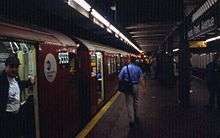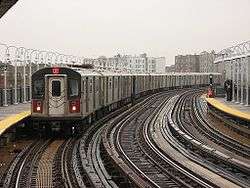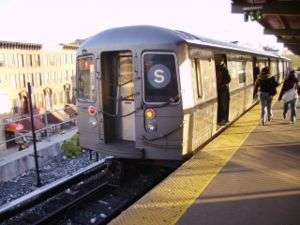R33 World's Fair (New York City Subway car)
| R33 World's Fair | |
|---|---|
|
R33WF 9306, in its original colors, leads the Train of Many Colors through 40 St – Lowery St on a <7> express run to Mets – Willets Point, April 2008 | |
|
Interior of R33WF 9306 | |
| In service | 1963-2001 |
| Manufacturer | St. Louis Car Company |
| Built at | St. Louis, Missouri, United States |
| Constructed | 1963 |
| Entered service | 1963 |
| Refurbishment | 1985 |
| Scrapped |
2001 (9321) 2010 (9339) 2013 (several cars) |
| Number built | 40 |
| Number in service | (28 in work service) |
| Number preserved | 2 |
| Number scrapped | 10 |
| Fleet numbers | 9306–9345 |
| Capacity | 44 (seated) |
| Operator(s) | New York City Subway |
| Specifications | |
| Car body construction | LAHT (Low Alloy High Tensile) steel |
| Car length | 51.04 feet (15.56 m) |
| Width | 8.75 feet (2,667 mm) |
| Height | 11.86 feet (3,615 mm) |
| Doors | 6 |
| Weight |
75,122 lb (34,075 kg) (pre-rebuild) |
| Traction system | Westinghouse XCA248E with Westinghouse (WH) 1447C |
| Auxiliaries | Motor-generator and battery set (WH YX304E) |
| Electric system(s) | 600 V DC Third rail |
| Current collection method | Contact shoe |
| Braking system(s) | WABCO, "SMEE" (electrodynamic) |
| Track gauge | 4 ft 8 1⁄2 in (1,435 mm) standard gauge |
The R33 World's Fair (R33 WF) was a New York City Subway car that was built in late 1963 by St Louis Car Company for the "A" Division before the 1964 New York World's Fair.
Description
The R33 World's Fair cars were numbered 9306–9345. The cars were very similar to the R33s, save for differently shaped side windows (three-piece curved windows on the R33 World's Fair cars as opposed to three-sectioned rectangular windows on the R33s), and the fact that the R33 World's Fair cars were single cars with a cab at both ends. The cars were built as single cars to make 11-car trains with the R36 WF cars, which were built as two-car sets (pairs).[1]
Although the R33/36 World's Fair cars were referred to as Redbirds, the cars were originally painted in a light turquoise blue and white upon delivery. This paint color scheme was used until the mid-1970s when they were painted in the silver/blue MTA livery. Then they were painted a full white (roof, bonnets, sides were all painted white) from 1981 to 1982 to combat graffiti; since the white paint was a Teflon-based paint, the graffiti did not stick to it very well. The look was abandoned for the famous Redbird style. The Redbirds were painted between 1984 and 1989 to a deep maroon red body, black front bonnets and anti-climbers, and a silver roof.
History

The first R33 World's Fair cars were placed in service on the 7 train on September 26, 1963. The cars were solely assigned to the 7 (IRT Flushing Line) and were based out of Corona Yard.
The R33 World's Fair cars were rebuilt in-house in 1985 by the Coney Island Shop. However, they were not retrofitted with air conditioning system and instead retained their original Axiflow ceiling fans. For this reason, they were not used during the summer months due to poor air circulation or air flow and high humidity.
Retirement

The R33 World's Fair cars were eventually replaced by the R142s and R142As. The last car, 9309, made its final trip on November 3, 2003 on the 7 service with ten R36WF cars, marking the end of the Redbirds.
Several cars have been preserved, including 9306, which has been part of the New York Transit Museum in Brooklyn since 1976 (the only R33 WF car to not be rebuilt), and 9327, which is at the Seashore Trolley Museum in Kennebunkport, Maine.
Most other R33 World's Fair cars were converted to work motors in the early 2000s, and handle such tasks as providing traction for B-Division rail adhesion cars and refuse trains. The cars that were not converted were 9306 and 9327, which are preserved as heritage cars, and 9321, which was retired and reefed in 2001.
The number "1" was placed before the former number (i.e. car 9345 became 19345) of some cars. The work cars are based out of various yards around the system and handle such tasks as providing traction for A-Division rail adhesion cars and refuse trains, and hauling cars during car moves between different subway yards.
Recently, however, the remaining R33 World's Fair cars have been decomissioned as they experience structural or mechanical issues. Retirement started with the reefing of 9339 in 2010 after it suffered from fire damage, and then the scrapping of a handful of cars for parts to keep other IRT SMEE cars running.
A detailed list of the statuses of the 40 R33 World's Fair cars is below, where bolded numbers indicate an active car (in work service):
| Car number | Location | Notes |
|---|---|---|
| 9306 | New York Transit Museum | Preserved by the New York Transit Museum. Never refurbished. |
| 9307 | Corona Yard | |
| 9308 | ||
| 9309 | Unionport Yard | Last unit in revenue service.[2] Part of the IRT Dyre Avenue Line rail adhesion train. |
| 9310 | Corona Yard | |
| 9311 | 239th Street Yard | |
| 9312 | Retired (2013) | Scrapped |
| 9313 | Scrapped | |
| 9314 | Scrapped[3] | |
| 9315 | 207th Street Yard | |
| 9316 | 239th Street Yard | |
| 9317 | Retired (2013) | Scrapped |
| 9318 | Scrapped | |
| 9319 | 207th Street Yard | |
| 9320 | Retired (2013) | Scrapped[4] Was renumbered to 19320. |
| 9321 | Retired (2001) | Reefed; never used as a work car. |
| 9322 | Unionport Yard | Part of the IRT Dyre Avenue Line rail adhesion train. |
| 9323 | Now numbered 19323. Part of the IRT Dyre Avenue Line rail adhesion train. | |
| 9324 | 239th Street Yard | |
| 9325 | Unionport Yard | Part of the IRT Dyre Avenue Line rail adhesion train. |
| 9326 | 239th Street Yard | |
| 9327 | Seashore Trolley Museum | Painted in Subway Series livery. |
| 9328 | Retired (2013) | Scrapped[5] Was renumbered to 19328. |
| 9329 | 239th Street Yard | |
| 9330 | 207th Street Yard | Now numbered 19330. |
| 9331 | ||
| 9332 | 239th Street Yard | |
| 9333 | 207th Street Yard | Now numbered 19333. |
| 9334 | Now numbered 19334. | |
| 9335 | Now numbered 19335. | |
| 9336 | Now numbered 19336. | |
| 9337 | Now numbered 19337. | |
| 9338 | Retired (2013) | Scrapped[6] Was renumbered to 19338. |
| 9339 | Retired (2010) | Caught fire and sunk as an artificial reef. Was renumbered to 19339. |
| 9340 | 207th Street Yard | |
| 9341 | ||
| 9342 | Now numbered 19342. | |
| 9343 | Corona Yard | |
| 9344 | 207th Street Yard | Now numbered 19344 |
| 9345 | Now numbered 19345. | |
See also
- R36 World's Fair - a married pair version and a very similar model also built by St. Louis Car Company.
References
External links
 Media related to R33 (New York City Subway car) at Wikimedia Commons
Media related to R33 (New York City Subway car) at Wikimedia Commons



